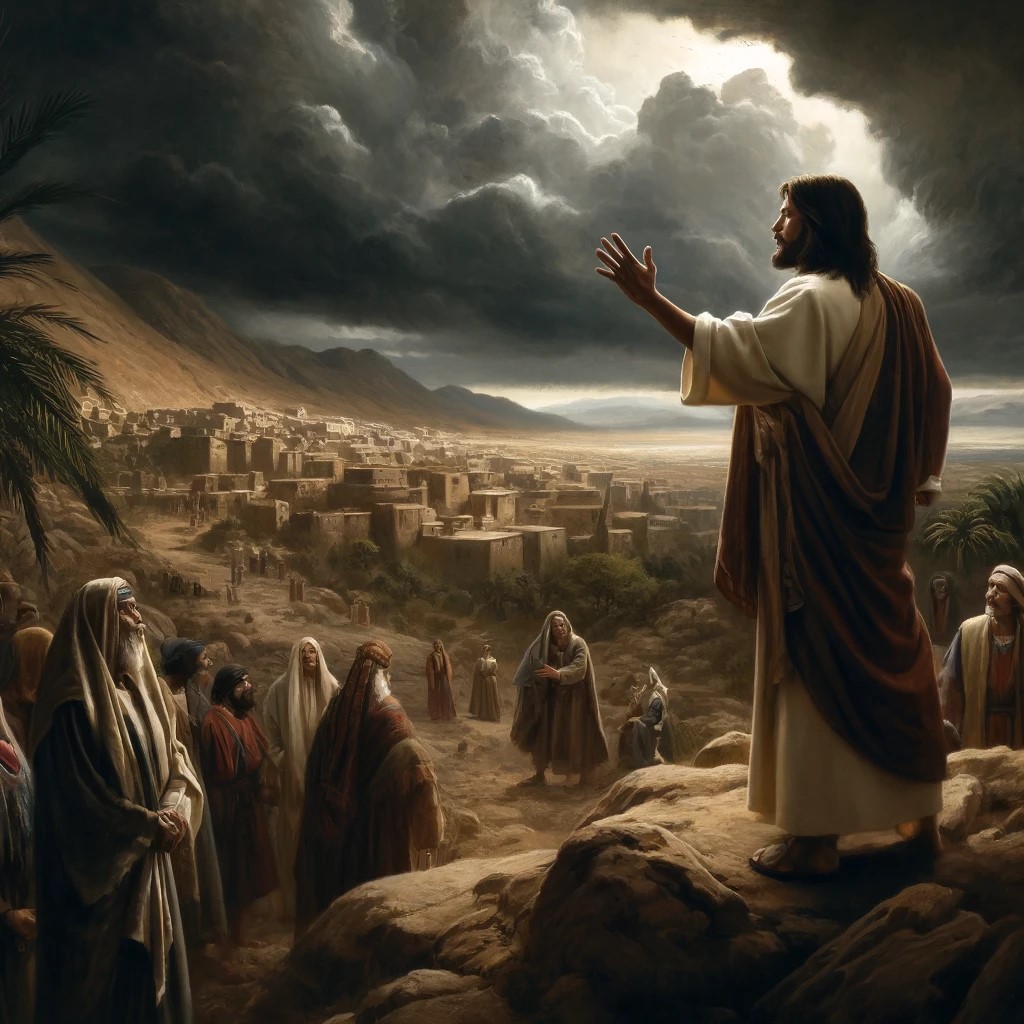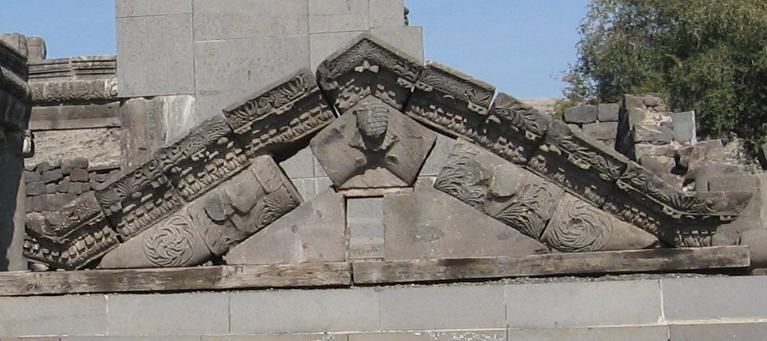Ruins of a Roman/Byzantine town, located above the north side of sea of Galilee, and is referred in the new testament as one of the cities condemned by Jesus.
Home > Sites > Sea of Galilee > Korazim (Chorazin)
Contents:
Background
Location
History
Photos
* Aerial View
* The Area
* Inside Korazim
* Synagogue
* Video Tour
Biblical
Etymology
Links
Background:
Korazim, also known as Chorazin, is an ancient village located in the Golan Heights region of Israel. The village is situated on a hill overlooking the Sea of Galilee and is believed to have been inhabited from the 1st century BC until the 8th century AD. The village was also an important center of Jewish life during the Roman and Byzantine periods and was known for its production of olive oil and wine.
Korazim is mentioned in the New Testament as one of the three cities that Jesus condemned for their lack of faith, along with Bethsaida and Capernaum. Matthew 11 21-22: “Then began he to upbraid the cities wherein most of his mighty works were done, because they repented not: Woe unto thee, Chorazin!…”
Today, visitors to Korazim can explore the ruins of the ancient village, which include the remains of a synagogue, a residential area, and a ritual bath. The synagogue is the most impressive site in Korazim, featuring intricate stone carvings and a large prayer hall. The village also offers stunning views of the Sea of Galilee and the surrounding landscape.
Location:
The site is located 4.5KM north to the sea of Galilee, 300M above the level of the lake. It can be approached either from the west (2KM from Vered-Hagalil junction) or the east (the road that climbs up from the Sea of Galilee to Almagor, 3Km away from the Moshav).
History:
- Roman/Byzantine
The city was established in the 1st century AD. The remains that are seen today belong to a later period, the period of the Mishna and Talmud (3rd/4th century AD), when the city was expanded.
Korazim is mentioned in the New Testament as one of the three cities that Jesus condemned for their lack of faith, along with Bethsaida and Capernaum.

Illustration of Jesus condemning the towns of Korazim, Bethsaida and Capernaum.
(Image created by AI using DALL·E through OpenAI’s ChatGPT)
The Jewish Synagogue was built in the Byzantine period, in the 3rd/4th century AD, according to a hoard of coins found under the synagogue. The synagogue is a typical rectangular 23M long, 17M wide, double row structure, north-south orientation. Its style is similar to the Capernaum and Hammat-Gader synagogues.
- Later periods
The site was destroyed at the middle of the 4th century, as described by Eusebius of Caesarea (published in his work – Onomasticon – at about 370 AD), which relates the destruction of the city to the prophecy of Jesus. This was also established by the excavations. The destruction may have been caused by an earthquake (363 AD).
The site was restored at the end of the 4th century, and continued until the 8th century. It expanded during the early Arabic period (7-8th century AD). After a gap of several hundred years, was revived in the 13th century. Near the entrance there is a tomb from the Mamluk period – the grave of Sheik Ramadan.
A small population was settled here from the 15th century until the last century. Bedouins from Syria that were settled in the ruins by the British after WW1 until 1948 when the site was abandoned.
- Modern times
New sites were established in the vicinity of Korazim: In 1946 Kibbutz Amiad; In 1961 Moshav Almagor and the farm Vered-Hagalil; In 1983: Chorazin, which shares the same name as the ancient site.
The site was excavated in 1875, 1905, 1926, 1962, 1965, 1980, 1983, and was restored and opened to the public as a national park.
Photos:
(a) Aerial view:
The ruins of the town cover about 100 Dunam (10 Hectares), and is located on a ridge that is divided by the road to Moshav Almagor. A quad copter view, taken above the east side of the site, is seen here.
Click on the photos to view in higher resolution…
The city has five quarters (north, west, south, east and central), where the central quarter includes the public houses and the synagogue. The town was not protected by a wall.
The major points of interest are marked on the aerial view below. The highlights of the national park is the synagogue, ritual bath (miqveh), mansions and houses, olive press and winepress installations. A walking trail was also opened to hike down to Capernaum.
(b) Vicinity:
This area is very dry, and water supply was essential for sustaining the life in this town. A spring is located on the north-east side, which was the source of the city’s water, in addition to the cisterns under the houses.
The city is located above the sea of Galilee, and an ancient road connected it to Capernaum (Kefar Nahum) below. It was an agriculture village, and famous for its wheat. An oil press was found on the western side of the city near the ancient road on the edge of the city.
(b) Inside Korazim:
Korazim is built from black basalt stones, the local stones in this volcanic area. Most of the stones are unhewn (rough and unfinished).
The ritual bath, an underground Mikveh, is located in the central quarter, north to the synagogue. It is based on a set of long stones that are placed over a cavity, as seen in the center (a similar structure can be seen near the ancient synagogue in Khirbet Kanaf). A cistern is located behind the bath (covered by an iron cover).
The structure next to the ritual bath, which includes arches.
In the following photo – some of the houses in the central quarter. In front of them – the main street of the city (North-South, which is right and left). There are narrow lanes between the houses, and most of the houses are adjacent to one another. On the left background is the synagogue.
(c) The Synagogue:
The 4th century AD synagogue was a classic Galilee type rectangular structure, made from black basalt stones, and built on a raised platform. It is one of the earlier Galilee synagogues.
This is the view of the south entrance and the outer court. It was accessed from the main street by a staircase, and there were 3 doors (the restored structure shows only the side door on the left and the central door on the right). A part of the decorated top of the door is seen on the floor.
The entrance to the Synagogue was decorated, and the reconstructed gable is located on the floor of the outer court and shown below.
A close up on the south-west side of the synagogue. The doors face the south – the direction of Jerusalem. The structure was damaged in the 4th century by an earthquake, and later restored and used until the 8th century AD.
The inner north side of the synagogue shows 5 of the columns out of the 12, which were arranged as a U shape. They supported the ceiling and roof, with windows on the sides. The floor was paved without mosaics, unlike other Galilee Synagogues from later periods.
A stone bench known, as the “Cathedra of Moses” type, is seen in the following photo (the original stone is displayed in the Jerusalem Museum). Its inscriptions, in 4 Hebrew lines, dedicate the bench to the memory of Yuden Bar Ishmael. The Hebrew words can be seen clearly starting with “remembered for good…”, right to left, on the top-right corner.
Many artifacts were found in the synagogue, some shown in these photos. There are stones with lions, birds, grape vines, head of medusa, menorah, temple, and more.
(d) Tour the site
![]() This 7 minute video summarizes a tour in the national park, conducted on February 2025.
This 7 minute video summarizes a tour in the national park, conducted on February 2025.
This park is a real gem: amazingly reconstructed, well kept and informative. Highly recommended!
New Testament References:
There are two identical references to Korazim (Chorazin) in the new testament, associated with the cities that did not accept Jesus and were condemned by him.
Matthew 11 21-22:
“Then began he to upbraid the cities wherein most of his mighty works were done, because they repented not: Woe unto thee, Chorazin! woe unto thee, Bethsaida! for if the mighty works, which were done in you, had been done in Tyre and Sidon, they would have repented long ago in sackcloth and ashes”.
Luke 10 10-13:
“But into whatsoever city ye enter, and they receive you not, go your ways out into the streets of the same, and say, Even the very dust of your city, which cleaveth on us, we do wipe off against you: notwithstanding be ye sure of this, that the kingdom of God is come nigh unto you. But I say unto you, that it shall be more tolerable in that day for Sodom, than for that city. Woe unto thee, Chorazin! woe unto thee, Bethsaida! for if the mighty works had been done in Tyre and Sidon, which have been done in you, they had a great while ago repented, sitting in sackcloth and ashes”.
Other References:
Apocalypse of Pseudo-Methodius:
This 7th century AD work holds a tradition that Antichrist would be born at Chorazin, educated at Bethsaida and rule at Capernaum – hence the curse of Jesus upon these cities as in the above texts.
Etymology (behind the name):
-
Korazim – source of name may be the root “Karoz” – which means in Hebrew “announcer”.
-
Chorazin – the Aramic name (as in the new testament)
-
Khirbet Karaze – the name of the Arabic place which preserved the ancient name. On this site there were Bedouins that were settled in the ruins by the British after WW1.
-
Vered-Hagalil– Hebrew: Rose of the Galilee (Vered is rose; Hagalil is “the Galilee”).
-
Almagor – Hebrew: do not fear. (Al – do not; Magor – fear).
Links:
* External:
- Korazim National Park
- Korazim – Preliminary Report, HA-ESI 131 2019, Ahia Kohn-Tavor
* Internal:
- Quadcopter Aerial views – collection of Biblical sites from the air
- Capernaum
- Bethsaida
BibleWalks.com – walk with us through the sites of the Holy Land
Hammat Gader <<<–previous site—<<<All Sites>>>—next Sea of Galilee site –>>> Mt Beatitudes
This page was last updated on Feb 4, 2025 (new tour video, aerial view with legend, links)
Sponsored links:
